Read The Tumblr Experiment, part 1: Introduction
 The blogging universe is huge and can feel overwhelming, so my students’ first challenge was to carve out a bit of it for our own community. Our first assignment was to create blogs and find each other. Enter the hashtag. Students know how to use hashtags to organize their posts or tweets around topics, so I use them with Tumblr as well. Our first one is aplang15hello. Hashtags are a great way to tame the vastness of the blogosphere, but I need something that’s easy to identify and stands out. The first part identifies the class and the second part, after the 15, is the subject. This is our way to “find” each other. We search for the unique hashtag which leads us to each others’ blogs. Then it’s a simple click on the “Follow” button and, hello audience.
The blogging universe is huge and can feel overwhelming, so my students’ first challenge was to carve out a bit of it for our own community. Our first assignment was to create blogs and find each other. Enter the hashtag. Students know how to use hashtags to organize their posts or tweets around topics, so I use them with Tumblr as well. Our first one is aplang15hello. Hashtags are a great way to tame the vastness of the blogosphere, but I need something that’s easy to identify and stands out. The first part identifies the class and the second part, after the 15, is the subject. This is our way to “find” each other. We search for the unique hashtag which leads us to each others’ blogs. Then it’s a simple click on the “Follow” button and, hello audience.
This first project, High Art, grew out of my frustration with the kinds of essays I typically assigned. I asked students to evaluate and make a case for a novel that they liked to be placed in our curriculum. As a writing assignment it was ok (zzzz), but the products lacked passion and voice. Students didn’t really care about novels or my opinion of novels, so they didn’t really care about the writing. My problem was that I didn’t know what they were passionate about and didn’t have a good way to find out.
 I also came up against the audience problem. Having their teacher as audience/evaluator/giver of points meant they wrote safe and “schooly”–their word–rather than honestly. I didn’t want safe writing. I wanted them to take chances, fail sometimes, learn and then come back again.
I also came up against the audience problem. Having their teacher as audience/evaluator/giver of points meant they wrote safe and “schooly”–their word–rather than honestly. I didn’t want safe writing. I wanted them to take chances, fail sometimes, learn and then come back again.
When I started to flirt with the idea of using Tumblr blogs in class, I lurked around in the space watching for and thinking about the kinds of writing I wanted my students to try, and I kept coming back to the idea of voice–authentic, honest and passionate. That voice, it seemed to me, was often found around subjects that the the writers were passionate about–music, movies, television shows, pop culture–sure, but still culture. And tucked in there among the pop culture were a lot of other things too–art things like body art and anime and illustrations. Art? Could I ask them to write about art? Why not?
It’s subjective. No one I was reading seemed able to clearly define it, but most of the writers seemed passionate that what they liked was most definitely Art. We were writing about novels, and it’s not much of a pivot from writing an argument about books to writing an argument about art. So, art it was. We looked at some examples of “high” and “low” art and culture, talked about criteria and evaluation and then jumped in. For their first assignment, I ask for students’ definition of art. I know. That’s daunting and very subjective, but for those very reasons it seemed like a logical starting point. It’s a challenging topic, but you can’t really get it “wrong.” And it’s a good way for students to introduce their “honest yet academic” selves. (More on this self idea in an upcoming post on Speaker–Who are you? Who do do want to be?)
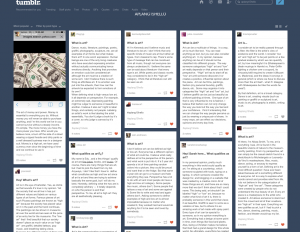 This image shows some of our initial forays on to the Tumblr microblogging platform. Tumblr microblogs typically offer shorter content than blogs, another aspect that drew me to it. It’s less daunting than the essay-like blog but more demanding that something like Twitter.
This image shows some of our initial forays on to the Tumblr microblogging platform. Tumblr microblogs typically offer shorter content than blogs, another aspect that drew me to it. It’s less daunting than the essay-like blog but more demanding that something like Twitter.
Students did pretty well once we got past the challenges. I always have to remind myself that just because my students are digital natives doesn’t mean that they are all good at technology. I had to work through issues of sign ups, access (my district, like many others, tends to be squeamish when it comes to anything that smells even remotely like social networking sites, so firewalls and filters are a constant challenge), how to “find” each other and the blogs we want to follow, commenting, and reblogging. There’s always something. My response is to remain calm and find a workaround. Eventually it all worked out, and we managed to create some content. It was mostly in the form of reblogging–repeating something interesting that you found on someone else’s blog–and then adding to the discussion with some original writing.
The students would mine the blogs they followed for content that they could write about and reblog under a our class hashtag–things they were genuinely interested in. Using the class hashtag meant it would show up in the feeds of their classmates. If they picked the right content and presented it well, they’d get a response for another classmate. If they didn’t, they wouldn’t.
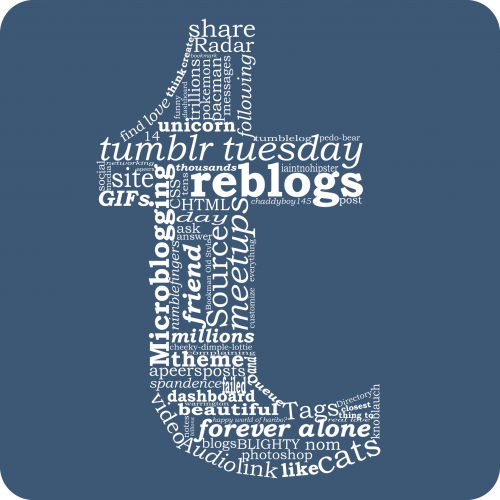 It’s here where our discussion about audience starts to bear out. What kind of writing attracts and holds our attention? Tumblr is an image rich environment with most users simply scrolling through until something catches their attention. The question for writers becomes: how do we compete for that attention?
It’s here where our discussion about audience starts to bear out. What kind of writing attracts and holds our attention? Tumblr is an image rich environment with most users simply scrolling through until something catches their attention. The question for writers becomes: how do we compete for that attention?
The images blur by, but my students agree that it’s often the writing that “sticks.” So how do we get “sticky?” I assign (compel?) my students to, in addition to writing their own content, reblog and comment on a certain number of their classmates’ posts. Making this an assignment is cheating because we’re not really creating any original content–more like offering opinions and observations–but it’s a good way to join the Tumblr discussion. It does require student bloggers to look at each others’ writing, but the challenge to attract attention, create a buzz, get sticky, is still with the writer. How do writers attract attention? What kinds of writing stick to a reader’s attention? Usually I’d approach these questions by assigning an essay and we’d start to close read and analyze it. Now the students’ work is where we start. I look through their work for what I call “good exchanges.”
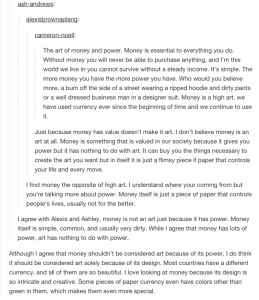
A “Good Exchange” showing a couple of students engaged in exchanging views over an idea about art.
The image at the right shows what a good exchange on Tumblr might look like. The original writer reblogged and wrote about something in a way that provoked his audience–his classmates–to “like,” “reblog,” and then respond. I’ll project this on the board and then we’ll talk about how and why the writing works. We give feedback and talk about the choices the writers made and how they worked. For me, this is a goldmine of teachable moments. I can talk directly to the intended audience because they’re sitting in the same room next to the writer who I can ask to talk about the choices she made and what her purpose was. We still close read professional writers, still look to the masters for guidance and models, but now I have another set of models, another set of writers. These writers are us. We’re not simply studying writing; we are writing, and about things we’re passionate about, just like Swift and Orwell and Wolff–all of whomI think would be terrific bloggers.
The Tumblr experiment is underway and most of the tech issues are solved. So where do we go next? It’s engaging and fun. My students like the attention, and I like having all of this material to use in my teaching but, they still ask me what it’s worth.
“Hey, um, Mr. Kreinbring-kreinbring65- or whatever we’re supposed to call you, points, how many are we getting for all this writing? Sure, it’s more engaging and all that but, you know, what’s my grade?”
They still ask that. They still have a hard time seeing past grades and points as the reason to do all of this writing. It’s not a question I like, but it is valid. How am I, their teacher, (and they still see me a that way, not as a fellow blogger) using all of this work to evaluate them? How am I rewarding good work and encouraging others to work harder at this?
I honestly do not know…yet.
I do know that my goal is to get students thinking of themselves as writers, as part of a community that skillfully uses words and images to explore ideas that matter to them, but they’re worried about their grades. Frustrating as it is I understand this, but we are moving in the right direction because they’re primarily looking more at one another as the audience and second at me as the “evaluator.” I see them engaging with each other but with an awareness of me. I don’t know if I’ll be able to completely move them from thinking of themselves as members of a class with the goal of getting a good grade to members of a community of writers with the goal of becoming better writers but this experiment; this feels like a first step in right direction.
 Rick Kreinbring teaches English at Avondale High School in Auburn Hills, Michigan. His current assignments include teaching AP Language and Composition and AP Literature and Composition. He is a member of a statewide research project through the Michigan Teachers as Researchers Collaborative partnered with the MSU Writing in Digital Environments Program, which concentrates on improving student writing and peer feedback. Rick has presented at the National Advanced Placement Convention and the National Council of Teachers of English Conference. He is in his twenty-third year of teaching and makes his home in Huntington Woods.
Rick Kreinbring teaches English at Avondale High School in Auburn Hills, Michigan. His current assignments include teaching AP Language and Composition and AP Literature and Composition. He is a member of a statewide research project through the Michigan Teachers as Researchers Collaborative partnered with the MSU Writing in Digital Environments Program, which concentrates on improving student writing and peer feedback. Rick has presented at the National Advanced Placement Convention and the National Council of Teachers of English Conference. He is in his twenty-third year of teaching and makes his home in Huntington Woods.
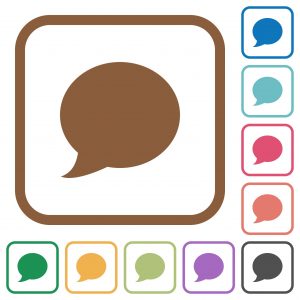 In the beginning of our blogging year, I always tell students to wait to comment on each other’s writing. There are always those who ignore me and add all sorts of silly comments with emojis. What they don’t realize is that I have to approve all comments first. I control this intentionally because I want to teach them how to comment.
In the beginning of our blogging year, I always tell students to wait to comment on each other’s writing. There are always those who ignore me and add all sorts of silly comments with emojis. What they don’t realize is that I have to approve all comments first. I control this intentionally because I want to teach them how to comment. Beth Rogers is a fifth grade teacher for Clarkston Community Schools, where she has been teaching full time since 2006. She is blessed to teach Language Arts and Social Studies for her class and her teaching partner’s class, while her partner teaches all of their math and science. This enables them to focus on their passions and do the best they can for kids. Beth was chosen as Teacher of the Year for 2013-2014 in her district. She earned a B.S. in Education at Kent State University and a Master’s in Educational Technology at Michigan State University.
Beth Rogers is a fifth grade teacher for Clarkston Community Schools, where she has been teaching full time since 2006. She is blessed to teach Language Arts and Social Studies for her class and her teaching partner’s class, while her partner teaches all of their math and science. This enables them to focus on their passions and do the best they can for kids. Beth was chosen as Teacher of the Year for 2013-2014 in her district. She earned a B.S. in Education at Kent State University and a Master’s in Educational Technology at Michigan State University. 
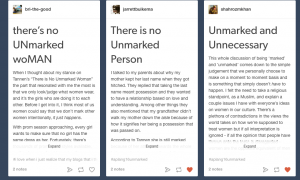
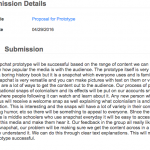
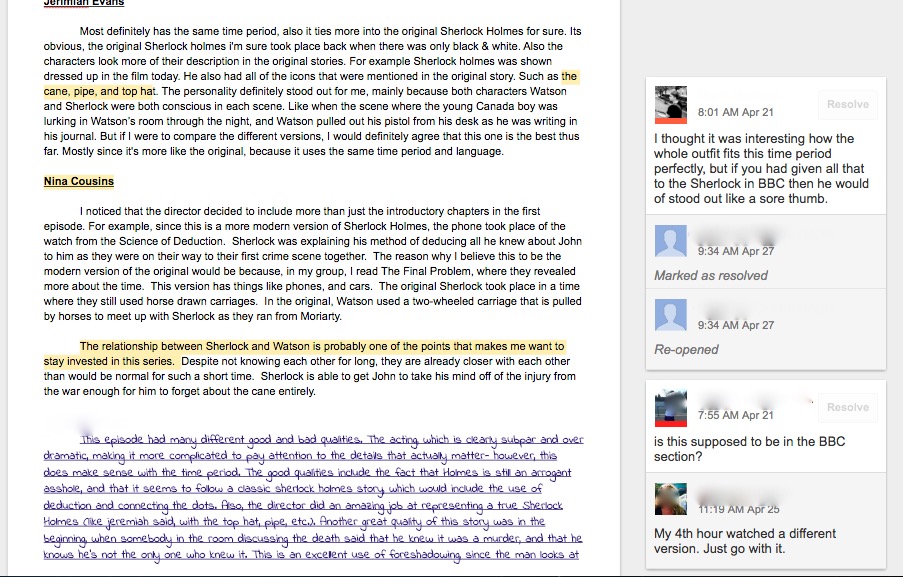
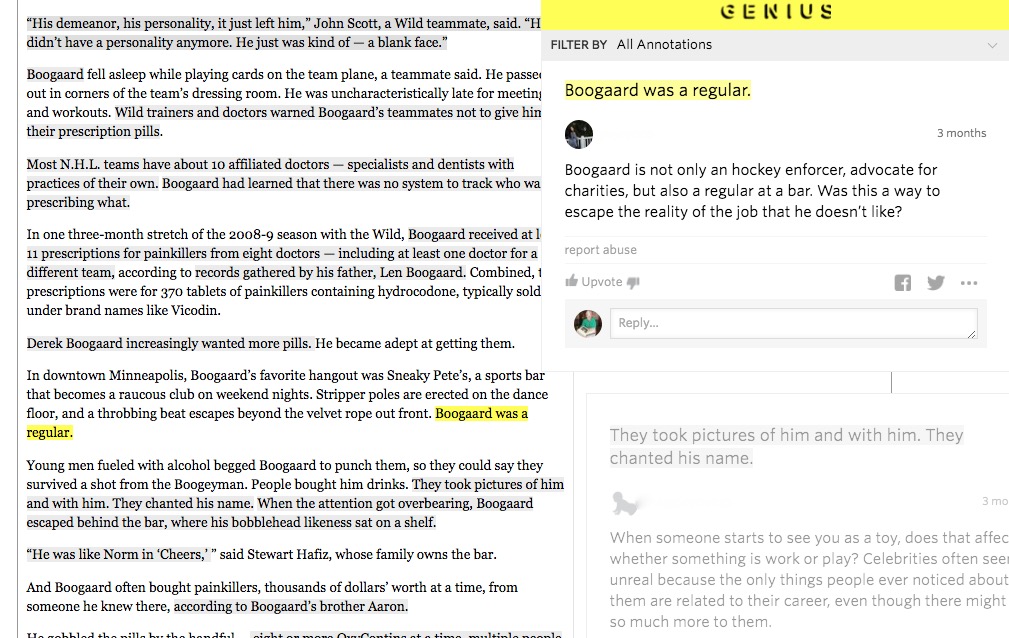
 Rick Kreinbring teaches English at Avondale High School in Auburn Hills, Michigan. His current assignments include teaching AP Language and Composition and AP Literature and Composition. He is a member of a
Rick Kreinbring teaches English at Avondale High School in Auburn Hills, Michigan. His current assignments include teaching AP Language and Composition and AP Literature and Composition. He is a member of a  For the past several years I have been having conversations with different people in my district about having our students create digital portfolios. This effort is finally gaining some ground, though the way has been painfully slow from my perspective.
For the past several years I have been having conversations with different people in my district about having our students create digital portfolios. This effort is finally gaining some ground, though the way has been painfully slow from my perspective. This project has also inspired students to create other sites about personal interests. Seeing the application of this skill in their personal life is exactly the kind of transfer we hope for, and the kind of artifact that students can highlight down the road.
This project has also inspired students to create other sites about personal interests. Seeing the application of this skill in their personal life is exactly the kind of transfer we hope for, and the kind of artifact that students can highlight down the road. If you are an educator, you know how quickly things can pile up around conference time and holiday breaks. Add in a few major life crises, and you can get way behind.
If you are an educator, you know how quickly things can pile up around conference time and holiday breaks. Add in a few major life crises, and you can get way behind. As the Tumblr experiment progresses, I’m faced with a difficult question about evaluation and feedback
As the Tumblr experiment progresses, I’m faced with a difficult question about evaluation and feedback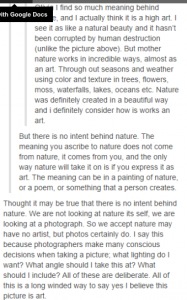
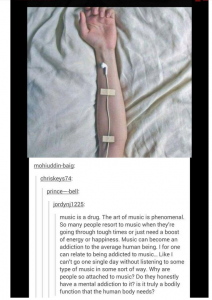
 The blogging universe is huge and can feel overwhelming, so my students’ first challenge was to carve out a bit of it for our own community. Our first assignment was to create blogs and find each other. Enter the hashtag. Students know how to use hashtags to organize their posts or tweets around topics, so I use them with Tumblr as well. Our first one is aplang15hello. Hashtags are a great way to tame the vastness of the blogosphere, but I need something that’s easy to identify and stands out. The first part identifies the class and the second part, after the 15, is the subject. This is our way to “find” each other. We search for the unique hashtag which leads us to each others’ blogs. Then it’s a simple click on the “Follow” button and, hello audience.
The blogging universe is huge and can feel overwhelming, so my students’ first challenge was to carve out a bit of it for our own community. Our first assignment was to create blogs and find each other. Enter the hashtag. Students know how to use hashtags to organize their posts or tweets around topics, so I use them with Tumblr as well. Our first one is aplang15hello. Hashtags are a great way to tame the vastness of the blogosphere, but I need something that’s easy to identify and stands out. The first part identifies the class and the second part, after the 15, is the subject. This is our way to “find” each other. We search for the unique hashtag which leads us to each others’ blogs. Then it’s a simple click on the “Follow” button and, hello audience. I also came up against the audience problem. Having their teacher as audience/evaluator/giver of points meant they wrote safe and “schooly”–their word–rather than honestly. I didn’t want safe writing. I wanted them to take chances, fail sometimes, learn and then come back again.
I also came up against the audience problem. Having their teacher as audience/evaluator/giver of points meant they wrote safe and “schooly”–their word–rather than honestly. I didn’t want safe writing. I wanted them to take chances, fail sometimes, learn and then come back again. This image shows some of our initial forays on to the Tumblr microblogging platform. Tumblr microblogs typically offer shorter content than blogs, another aspect that drew me to it. It’s less daunting than the essay-like blog but more demanding that something like Twitter.
This image shows some of our initial forays on to the Tumblr microblogging platform. Tumblr microblogs typically offer shorter content than blogs, another aspect that drew me to it. It’s less daunting than the essay-like blog but more demanding that something like Twitter. It’s here where our discussion about audience starts to bear out. What kind of writing attracts and holds our attention? Tumblr is an image rich environment with most users simply scrolling through until something catches their attention. The question for writers becomes: how do we compete for that attention?
It’s here where our discussion about audience starts to bear out. What kind of writing attracts and holds our attention? Tumblr is an image rich environment with most users simply scrolling through until something catches their attention. The question for writers becomes: how do we compete for that attention?
 Rick Kreinbring teaches English at Avondale High School in Auburn Hills, Michigan. His current assignments include teaching AP Language and Composition and AP Literature and Composition. He is a member of a
Rick Kreinbring teaches English at Avondale High School in Auburn Hills, Michigan. His current assignments include teaching AP Language and Composition and AP Literature and Composition. He is a member of a 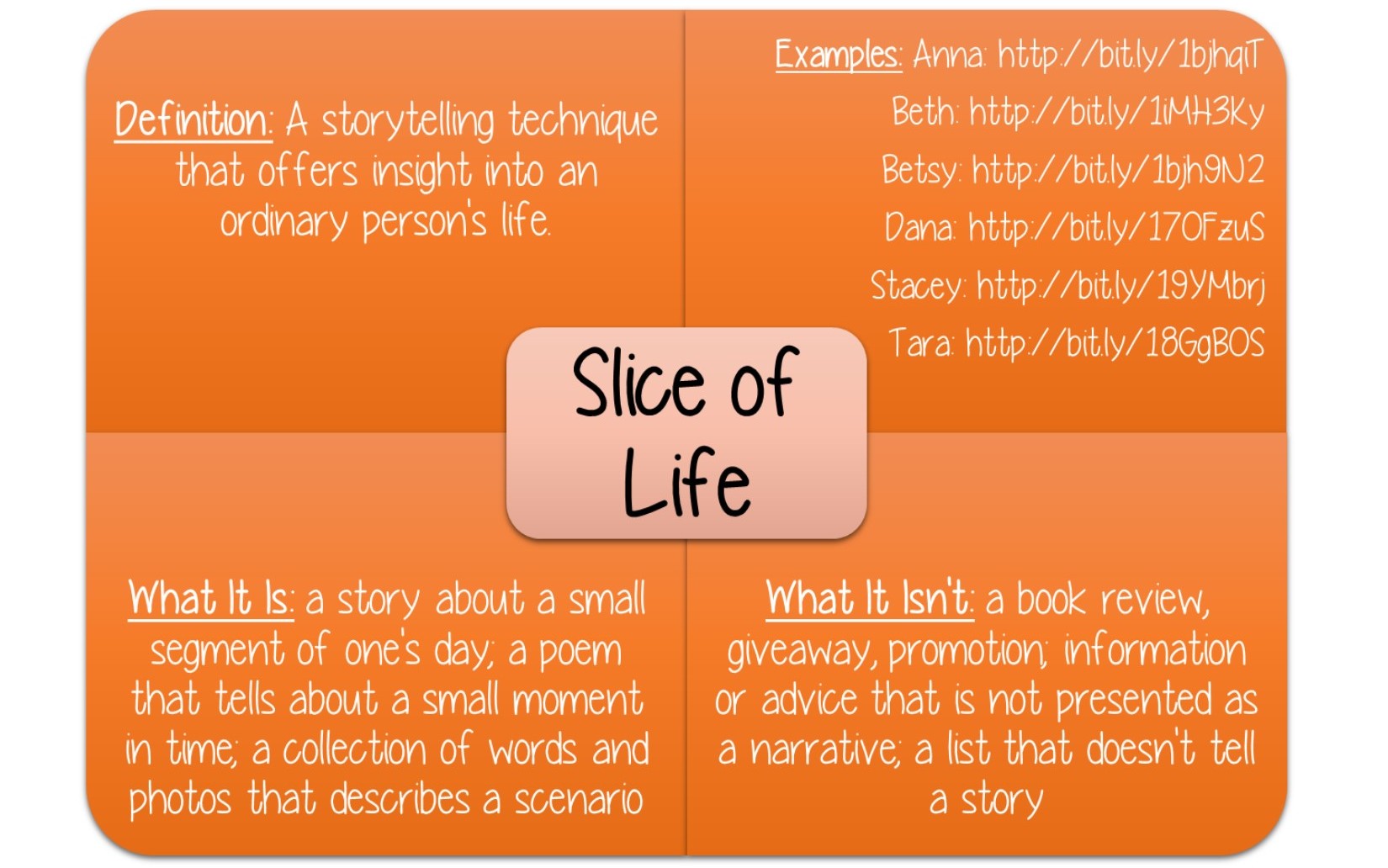 28 weeks. When I hear this I think of being just more than halfway through a pregnancy. While I am not having a baby, I am witnessing the growth and development of my classroom of writers. According to my teacher blog, I have assigned 19 posts, not counting the daily expectation for this month. We have been blogging weekly since the school year began. I started this process mainly as preparation for the
28 weeks. When I hear this I think of being just more than halfway through a pregnancy. While I am not having a baby, I am witnessing the growth and development of my classroom of writers. According to my teacher blog, I have assigned 19 posts, not counting the daily expectation for this month. We have been blogging weekly since the school year began. I started this process mainly as preparation for the  Does this mean that all of my students are suddenly writing beautiful blog posts, with wonderful spelling and grammar? Nope. In fact, there are some downright cringe-worthy pieces of writing on our class pages. But they are excited, they want to write, and they are paying more attention. When we give comments, I tell my students to tell the writer specifically what they have done well. My hope is that they will begin to transfer some of this attention to their own work. In small increments, I am seeing evidence of this. I only have to scroll back to September to see the growth right in front of me. I also set out Chromebooks at conferences so parents can peruse their child’s blog while they wait. This is very informative and often makes conversations easier.
Does this mean that all of my students are suddenly writing beautiful blog posts, with wonderful spelling and grammar? Nope. In fact, there are some downright cringe-worthy pieces of writing on our class pages. But they are excited, they want to write, and they are paying more attention. When we give comments, I tell my students to tell the writer specifically what they have done well. My hope is that they will begin to transfer some of this attention to their own work. In small increments, I am seeing evidence of this. I only have to scroll back to September to see the growth right in front of me. I also set out Chromebooks at conferences so parents can peruse their child’s blog while they wait. This is very informative and often makes conversations easier. Beth Rogers is a fifth grade teacher for Clarkston Community Schools, where she has been teaching full time since 2006. She is blessed to teach Language Arts and Social Studies for her class and her teaching partner’s class, while her partner teaches all of their math and science. This enables them to focus on their passions and do the best they can for kids. Beth was chosen as Teacher of the Year for 2013-2014 in her district. She earned a B.S. in Education at Kent State University and a Master’s in Educational Technology at Michigan State University.
Beth Rogers is a fifth grade teacher for Clarkston Community Schools, where she has been teaching full time since 2006. She is blessed to teach Language Arts and Social Studies for her class and her teaching partner’s class, while her partner teaches all of their math and science. This enables them to focus on their passions and do the best they can for kids. Beth was chosen as Teacher of the Year for 2013-2014 in her district. She earned a B.S. in Education at Kent State University and a Master’s in Educational Technology at Michigan State University.